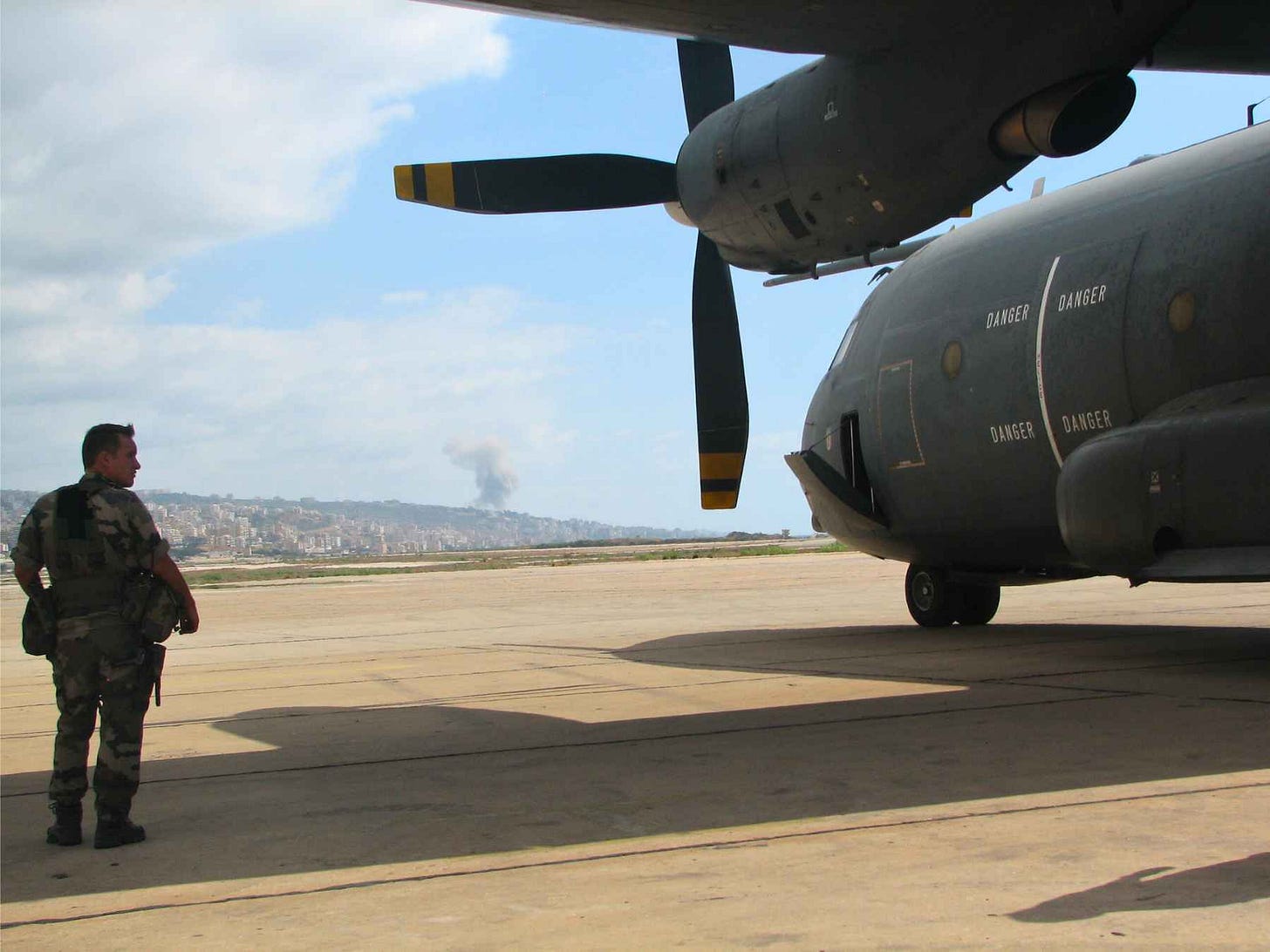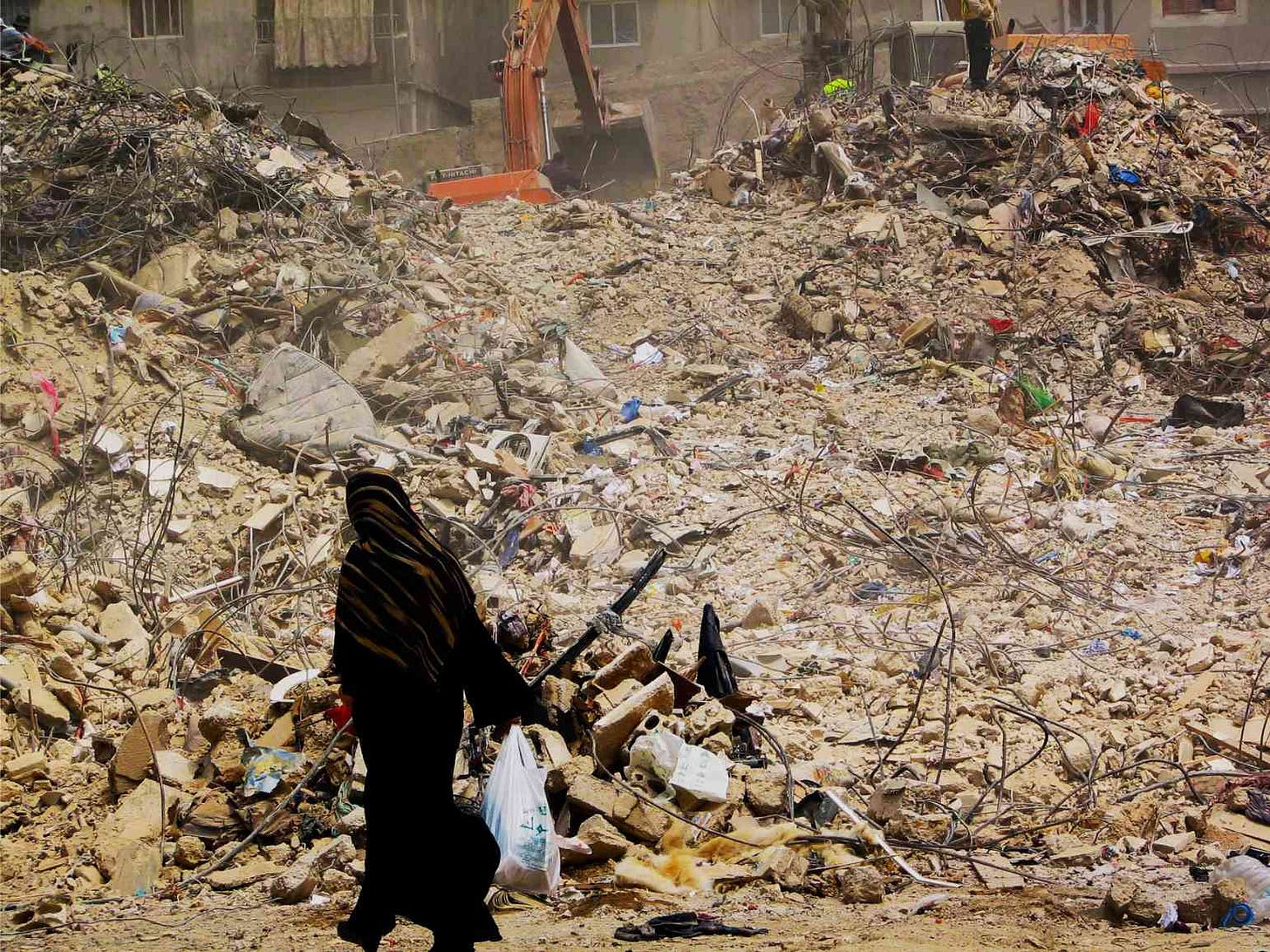Then looking at [Ares] darkly Zeus who gathers the clouds spoke to him: “Do not sit beside me and whine, you double-faced liar. To me you are the most hateful of all gods who hold Olympus. Forever quarrelling is dear to your heart, wars and battles. […] And yet I will not long endure to see you in pain, since you are my child, and it was to me that your mother bore you.” -Homer, Iliad
During the 2006 Lebanon War—the last major outbreak of war between Israel and Hezbollah—I was working as a reporter in Nicosia for the Cyprus Mail. I flew to Lebanon twice, the first time embedded with the US military to cover the evacuation of American nationals from Beirut to Cyprus on the USS Nashville and the second time solo to cover a humanitarian mission of Médecins du monde in Beirut and Southern Lebanon.
With the Gaza conflict, and with the increased possibility that war again breaks out in Lebanon and even beyond, the account of my experience during that 2006 war—yet another phase of this grim 85-year conflict—feels newly relevant. As Twain said, history rhymes.
I offer the first part today and will publish the rest on Thursday. Interspersed are photos, which I took throughout that trip.
This piece avoids the meat grinder of the conflict vis-à-vis history and politics. Yes, I was in Lebanon, not northern Israel, so my account will obviously reflect that experience. But think of this more as the wide-eyed chronicle of a war journalism virgin who finds himself in a conflict zone. It’s more journal than screed.
Perhaps because I am a father now, and perhaps because of the heinous and harrowing uncensored footage disseminated through social media, I’ve found this latest outbreak of war—from the moment Hamas paraglided in like pterosaurs of death to the siege and razing of Gaza—especially upsetting in its blithe disregard and fatalistic shoulder-shrugging over the killing of children.
I have also noticed that those quickest to condemn the perceived (and often misperceived) beliefs and political allegiances of others are also often those quickest to shut an eye to the suffering of the “other team,” to use an unfortunate sports analogy that Biden recently used. The messy calculus of war is bloody, no doubt, but we should be alert to the dangers of the Cyclops, who may be fearsome, but who is also blinkered and vulnerable in his tunnel vision.
Homer sings to us in the Iliad, “Ares in the likeness of a dark stormcloud bellowed, now from the peak of the citadel…”
Indeed, he did. And now the stormclouds have gathered again.
Part I:
The eve of the ceasefire
Aug 13, 2006
IT WASN’T YOUR EVERYDAY airplane announcement: “Attention: due to bombings in Beirut, we will have to circle for an indefinite period over the sea.”
But the French military plane—loaded with pallets of humanitarian aid, two Handicap International employees, a Dutch embassy entourage, two journalists including me, and a dozen armored French soldiers—only had to circle over the Mediterranean a few times. Twenty minutes later, the C-130 touched down on one of the remaining intact strips at Beirut airport.
Only minutes after we disembarked, a plume of smoke mushroomed in the distance. The final day before the ceasefire—the 33rd day of Israeli air strikes—was not panning out to be a quiet one.
Once a French military officer returned our passports, we climbed into a French embassy van. An M-16 was propped against the passenger dashboard. The need for guns in southern Lebanon, where a ground war was underway, made sense, but assault rifles seemed futile in the face of air and naval bombardment. The giant French flag draped over the van’s roof seemed far more practical, though considering that warplanes had hit a UN post and ambulances, perhaps that too was mostly for comfort.
As we drove into the city center, our guide told us a ceasefire had been agreed upon for the next day. Heavy bombing was expected in southern Beirut, possibly also West Beirut, throughout the day and night.
The van could not take me as far as my hotel, the Mayflower. Instead, they dropped me off near the French embassy at a plush downtown hotel where the other journalist, who worked for a French radio station, was staying.
Before leaving, the guide told me that the West Beirut Sunni Muslim quarter of Hamra, where my hotel was located, was unsafe due to its proximity to the strikes. He advised I stay here instead.
The other journalist, who was on his own, seized upon this advice. “Yes, I would if I were you, it’s much safer!”
But I already had a reservation at the Mayflower. And the two members of the Cyprus Médicins du Monde—who had just arrived on a Canadian chartered boat and whom I would be shadowing around Beirut—were staying there.
He made one last attempt. “Maybe stay just for tonight, since it’s supposed to be the worst night…”
But I was set in my decision. And, besides, the hotel charged double the Mayflower’s rate. I flagged a taxi and headed for Hamra.
Once we arrived in Hamra, the picture of desolation and abandonment that the guide’s warning had conjured in me was dispelled. Though we were only a few kilometers from the Shiite neighborhoods that Israel was pounding, people were on the streets, grocery stores were open, and a few kids were kicking a ball about.
The street life surprised me. There were even a few window-shoppers out. The only sign that this was not an average late Sunday afternoon was the teenagers siphoning petrol out of a Mercedes.
Media coverage of conflicts gives the impression that during war every person is under siege and thinking about nothing but staying alive. The words “War in Lebanon” or “Israel Attacked” scroll in red across your TV screen under video footage of demolished structures or the fire from a Katyusha rocket blast, so you imagine that everyone in Lebanon and northern Israel is locked in a life-and-death struggle. But what is not shown—unless it serves propaganda purposes—is that while the bombs may be falling several kilometers away, human life, in all its mundanity, must go on.
This is not to say anyone is oblivious to the war. Like a belligerent drunk, war makes itself heard, however unwelcome its presence. No coincidence that the Greek god of war, Ares, was usually portrayed as a disliked, blustering lout.
It was while unpacking in my hotel room that I heard the distant roar of Ares. I grabbed my hotel keys and rushed into a surprisingly quiet hallway and then down to reception. It was as if I had hallucinated the blast.
“Did you hear that?” I asked the desk attendant.
He eyed me for a moment and then laughed. “That was nothing. Earlier the front door was swinging back and forth from the bombs.”
The sound of explosions had become background noise, like heavy thunder. In fact, just before sunset—while I was standing on the roof, listening to the call to prayer wailing from the minarets that sent lengthening fingers of shade across the warmly lit city—I briefly thought there was a thunderstorm underway.
Within a dense cluster of clouds, I saw flashes of light, which were followed by a rumbling sound. But then a cloud of smoke rose in the same area. It was no storm, at least not of the meteorologic variety.
There’s something dreamlike about being in a city under bombardment (so long as the bombs aren’t falling on your head). The distant rumbles, the vibrations underfoot, the power outages, these all help impart the feeling that you’ve been transported to some other world where daily life, though not ceasing, has been stripped of superficialities and where the usual disinterest among strangers is replaced by an undercurrent of solidarity.
It’s strangely seductive and addictive. I’d venture that part of why war journalists feel such an urge to rush into every conflict is the craving for another fix.
Later that night, at the hotel bar, I spoke with a veteran war photographer who had been chasing bombs throughout Lebanon to get post-explosion pictures of ambulance workers and victims. He said it was especially difficult for press to cover the strikes because Israel would often hit the same spot after an interlude.
He recounted how last week in Tyre, NYT Magazine writer Scott Anderson had his eardrum blown out upon arriving at the site of a drone attack on a suspect. Anderson, the photographer Paolo Pellegrin, and their driver were in the lead car of a caravan of journalists. They had just pulled up near the injured man when an Israeli drone fired a second missile 200 meters from them, killing the man, and giving the three of them mild concussions and shrapnel wounds (the car windshields shattered under the force).
“Scott has been walking around with tissue sticking out of his ear,” he said. “I’ve been a lot of places, but these bombs are something else. There are places where it looks like Hiroshima.”
He had been to multiple war zones and seemed a reasonable fellow, but this seemed a gross overstatement. It was only a few days later, when I would visit the epicenter of the strike zone in Southern Beirut and see entire blocks leveled to hills and valleys of rubble, that I would get the thrust of his words.
“There’s an incredible vacuum effect when the bombs hit,” he continued. “You can wear a helmet and a bulletproof vest, but the shrapnel will get you in the face and neck. The first three weeks here I was fine, but now I hear the explosion and my heart jumps.”
If his heart did jump, it didn’t jump very far. A moment later there was a distant rumble. “There goes another,” he said in a flat tone and sipped at his beer.
The following morning, an explosion overhead jarred me out of sleep.
(TO BE CONTINUED ON THURSDAY)









Will to be back to read this entry in full. 🐈⬛
Airplane announcement: “Attention: due to bombings in Beirut, we will have to circle for an indefinite period over the sea.”
That would be one of the best movie intros scenes. Then pan to worried face of young journalist...